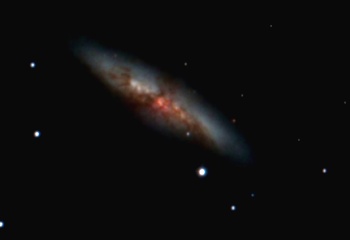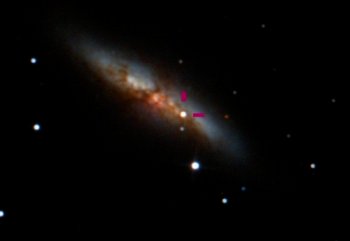

Eleven and a half million light years away and eleven and a half million years ago a type Ia supernova exploded in Messier 82, or the Cigar Galaxy. The first light showed up here about January 15 or 16. Some one finally noticed it on January 21st. I took pictures of M82 on 12/27/13 and then again two days after it was discovered. It appears to be magnitude 11. The brightest star in these pictures is 10.0 magnitude. Notice that it appears a bit reddened -- probably due to significant galactic dust in the line of sight.
 |
 |
|
| Photo: Rick Whitten, 12/27/13 36m ISO 1600 | Photo: Rick Whitten, 1/23/14 38m ISO 1600 |
You will recall from a previous article Supernovae From Degenerate Stars, that Type Ia supernovas are carbon-oxygen white dwarfs that gain enough mass to re-ignite fusion reactions. The entire mass of the star fuses in a few seconds, creating heavier elements and blowing the star apart.
An astronomer was quoted in the mainstream media as saying that Hubble had previously imaged M82 and that it might have captured the progenitor to SN 2014J. Umm... NO! White dwarfs can be incredibly hot stars with surface temperatures between 8,000 and 40,000 Kelvin. A white dwarf that will go supernova is probably near the upper mass limit of 1.38 solar masses. The more massive a white dwarf, the smaller (because the matter is degenerate), therefore SN 2014J's was probably considerably smaller than Earth. The result is an absolute magnitude between +10 and +15. Absolute magnitude is how bright the object would appear at 10 parsecs or 32.6 light years. I've already performed the calculations for this issue in How Far Can I See?. A 9th (absolute) magnitude star can only be seen by Hubble at up to 1.3 million light years. The progenitor to this supernova would have been invisible by more than a factor of 10 in distance, a factor of 100 in luminosity, or 5 magnitudes.
The same astronomer was quoted by the media as suggesting that we might have detected neutrinos from the neutrino flash. Again, we needn't do much math to put the kabash on that idea. SN 1987A in the Large Magellanic Clouds produced about 11 neutrinos at one of the best detectors at the time. SN 1987A was a type II supernova 168,000 light years away or about 70 times closer than SN 2014J. So the neutrino flash from SN 2014J would be on the order of 5,000 times fainter, if it had been a type II supernova. But the neutrino flash from a type Ia supernova is expected to be 1/1000 times fainter than from a type II supernova. So the neutrino flash should be about 1/5,000,000 as bright as the one from SN 1987a which only produced 11 events. Hmmm. How many events would we expect from the M82 supernova? There would be one in a half million chance of seeing ONE neutrino from this event. We would need to see 3 or 4 from any event to get several standard deviations beyond coincidence. Even if one had been seen, it wouldn't mean a thing.